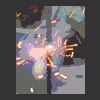Interesting to see there are so many people making their own firing systems. I came across this post while searching for some information relating to firing controllers. I've been into model rocketry for some time, but I've also had a keen interest in fireworks and I'm looking to take a training course, and hopefully get some practical experience eventually leading to a BPA exam.
That aside, mostly out of my own curiosity, I'm thinking (and have been for a while, but lack of time and all...) of designing and building my own firing controller. At the moment its applications would be purely for model rocketry, but in essence model rocket ignitors and pyro E-matches are the same. Clearly there are different specs with regard to continuity test current, firing current, etc... but it should be possible to make a system that will work safely in either application.
Now, I'm also heavily into electronics (I work in electrical and electronic engineering) and, in particular, microcontrollers and computers. I've looked over the FireOne system and would like to implement many of the features found within it. Here's my outline specification of what I'd like my system to do:
- Minimum 32 cues per firing module
- No need for separate firing rails, binding posts integrated into firing module
- Capacitive discharge firing circuits, each cue isolated from all other cues with its own capacitor to prevent the entire system being discharged in the event of firing into a dead short
- E-match continuity check, firing modules can report back the resistance of any igniter to central firing unit with accuracy of 0.1 Ohms
- Firing modules powered and controller by master host
- Only one combined power and control cables to all units in daisy chain or star wiring configuration
- LCD display for addressing and settings on firing modules
- Central programmable control unit for manual firing or pre-choreographed shows in semi-auto (i.e. press a button to advance to the next cue) and possibly full-auto with timing if this doesn't pose a safety hazard
- Computer control as a future possibility
Of course, that's just a few of the things I'd like to do with the firing modules. There will, of course, be all the usual safety features, the main firing controller will be designed for manual or pre-choreographed shows, and adding PC control would be a snap in hardware terms if I can manage to write a usable piece of software.
What I don't intend to do is transmit over bellwire. Instead, I'd prefer to use cat5 cable between all firing modules and central control unit. Its not as cheap, but its not expensive either, and its designed for use in data systems. It has enough cores to carry the power, and could also be used to carry DIFFERENTIAL transmit/receive RS-485 lines between the controller and firing units. As far as I'm aware FireOne doesn't do this, in fact I don't see how it could without using more cores and twisted pair cables.
Quite clearly the FireOne system does work, but one would assume that once you start getting some lengthy signal cables in the system you'd be picking up a lot of interference and losing a lot of data packets over the connection. It could only get worse in larger displays where even more cable is used, and these displays are going to be the ones that require the most bandwidth! I guess that's why they added the ability to store the show in the firing module and then run it using timecode.
Of course, I haven't done any of this yet. I'm trying to start a business and at the moment anything else is on the back burner, along with taking up any spare time and money I might have otherwise had. Nontheless, I'd love to hear from anyone that might be interested or has any feature suggestions for the system.
Of course, I'd be happy to design and build this system to some sort of timescale if there was potentially some gain at the end of it. In fact, if comparable systems were sensibly priced then I wouldn't be bothering to design my own at all, but its a niche market and manufacturers seem to be able to over-hype their prices.
Oh, and after all that rambling onto what I actually meant to ask. When I do make a start on this, I'll be needing to get hold of some E-matches for testing. However, I can't find *anywhere* in the UK selling them. Are there laws limiting their sale, perhaps because of the explosive coating on the tip? How do I get hold of them?
I hope this didn't hijack the thread too much, apologies for going on a bit! Hope you're all holding up ok in the weather.
Matthew
p.s. Mods, if you do feel this isn't particularly relevant to the thread then do feel free to split to a new topic. Cheers.
Edited by electronicsuk, 19 January 2007 - 06:17 PM.

















